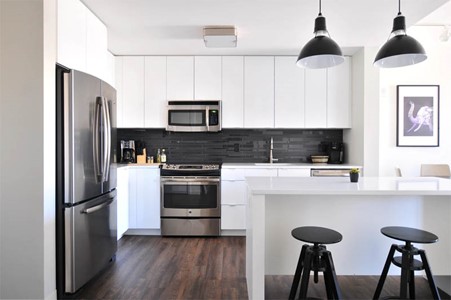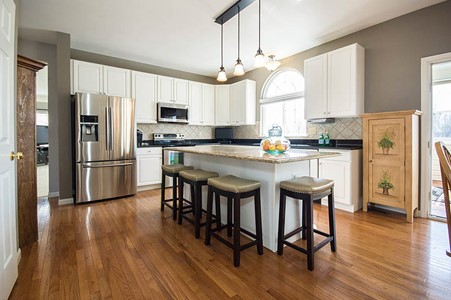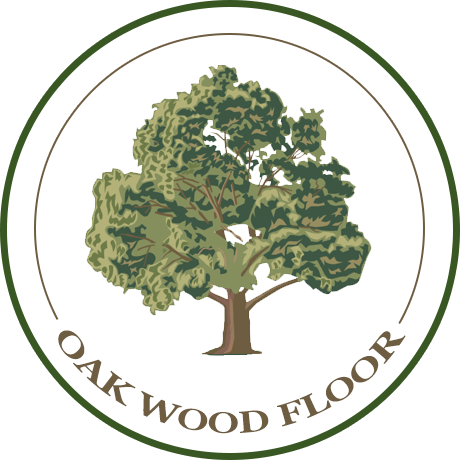Many people are re-doing their homes and want to bring a stylish and contemporary look to their kitchen. Choosing the right flooring can have a huge impact on the overall look and feel of the space. In the Victorian and Edwardian times, large houses with kitchens would have exposed timber floors, recent trends had marble, slate or tile was fashionable for kitchens. Still, But many people are seeking the design aspect and feel that wood flooring can bring to a kitchen. However, most are unsure if you can use wooden floors in a kitchen and if it is a good idea. So, the question we will answer today is whether you can and should have wood flooring in your kitchen.
Overall the simple answer to the question is YES. However, because of the level of traffic and environment of a kitchen, it is important to understand what type of wood should be used and how it should be fitted.
What type of hardwood floor should you use in your kitchen?
There are two main types of wood: solid planks and engineered wood. You can find out more about these options in some of our previous articles.
As wood is a natural and organic product, it therefore expands and contracts when exposed to moisture and temperature. In an environment like a kitchen where steam and heat change is commonplace, this needs to be considered. Due to its overall structure, solid wood isn’t the preferable option. However, as a result of its layered structure, engineered wood flooring is far less susceptible to heat and moisture and works well.

The level of expansion and contraction that engineered wood flooring experiences is minute in comparison to that of solid wood flooring. It can work therefore be perfectly suited for the conditions usually experience in a home kitchen.
Please note that all hardwood floors will still experience a degree of expansion when the temperature rises but will restore to its original form shortly after the room returns back to the original temperature. With engineered wooden floors this contraction and expansion is so tiny as to be imperceptible.
However, if not fitted properly this slight expansion can still create a problem. When installed an expansion gap should be left in place for these atmospheric changes. These expansion settings are almost invisible and in no way detract from the overall beauty of the floor. A correct fitting can ensure that your new kitchen floor will not encounter any issues.
Protecting the Wood Flooring in your Kitchen
However, although engineered wood flooring is remarkably resilient to environmental factors, it is still very important that your floor is protected properly and that you make a conscious effort to ensure that there is no significant amounts of moisture added to the wood. This means that you will need to immediately clean up any spills or splashes to minimise the risk of absorption.

It is not only day-to-day moisture from a kitchen environment that should be considered. It is essential to make sure to check your plumbing for any leaks and make sure that it is in good condition. Furthermore, dishwashers or washing machines should be frequently checked for water-tightness, along with any other kitchen machinery. Excess water sitting on the wood could cause significant damage to the floor and should be avoided.
A major benefit to using engineered wood flooring is that it can be strategically set around your machinery so that if there is a small leak this will not spread to the rest of the floor. With older houses where plumbing sometimes ran under the flooring, it is quite possible to create inspection points that can be easily accessed. These inspection points allow for much smoother work if you do encounter plumbing problems and can be made practically invisible with wooden flooring.
With regards to cleaning an engineered wooden floor, it is as simple to clean as most other surface floorings. Sweeping and light mopping should be that is all that is needed once the floor has been fitted.
However, depending on the level of traffic that your kitchen experiences you will need to regularly top up the finish of the flooring. Using a good lacquer or oil will ensure that your wood will stay protected over a long period of time.
What if my kitchen has underfloor heating?
Underfloor heating will also have an impact on how you get you to install wood flooring in your kitchen. If your kitchen does have underfloor heating, then you will need an Engineered Hardwood floor which can be installed as a floating floor or as a glue-down system. This depends on the type of heating that you have previously installed. Our hardwood specialists will be able to further assist with this aspect of installation. It is advised that nailing or stapling down the flooring is not used as it could potentially pierce any pipes underneath the flooring.
Maples & Birch supply a wide range of engineered wooden flooring which are 100% suitable – so yes you can have wood flooring in your kitchen.
Maples & Birch have a wonderful range of engineered flooring, which is available to buy direct at truly affordable prices. If you are thinking of installing wood flooring in your kitchen please consider ordering a free sample to see for yourself the excellence and finish of your chosen floor?
Flooring for kitchens can be supplied as engineered planks. Installing flooring is a specific skill and it is always best to work with a professional installer to ensure the highest standards.
Visit our catalogue pages to see the full range available or for more information and a free consultation please contact the Sales Team at: 0333 533 3330
If you are looking to buy oak flooring online we have partnered with Maples & Birch who have one of the largest rages of oak and other species wood flooring in the UK
